Isotopic Studies in South American Mammals: Thirty Years of Paleoecological Discoveries
Abstract
1. Introduction
2. Materials and Methods
2.1. Bibliographic Data Acquisition
2.2. Database Processing
- All terms were standardized to American English (e.g., palaeoecological to paleoecological).
- Terms were written in the singular (e.g., isotopes to isotope).
- Terms referring to animals were written using the scientific name (e.g., horses to Equidae; mammals to Mammalia).
- Hyphens were removed (e.g., radiocarbon-dating to radiocarbon dating).
- Geographical regions were renamed to country names (e.g., North Argentina to Argentina).
2.3. Bibliometric Network Analysis
3. Results and Discussion
3.1. Temporal Trend Analysis
| Author/s | Year | Title | n | Reference | |
|---|---|---|---|---|---|
| 1 | Cerling et al. | 1997 | Global vegetation change through the Miocene/Pliocene boundary. | 1737 | [17] |
| 2 | Latorre et al. | 1997 | The expansion of C4 grasses and global change in the late Miocene: Stable isotope evidence from the Americas. | 250 | [25] |
| 3 | Cerling et al. | 1998 | Carbon dioxide starvation, the development of C4 ecosystems, and mammalian evolution. | 212 | [71] |
| 4 | MacFadden | 2005 | Diet and habitat of toxodont megaherbivores (Mammalia, Notoungulata) from the late Quaternary of South and Central America | 137 | [73] |
| 5 | MacFadden and Shockey | 1997 | Ancient feeding ecology and niche differentiation of Pleistocene mammalian herbivores from Tarija, Bolivia: Morphological and isotopic evidence. | 125 | [72] |
| 6 | Tejada-Lara et al. | 2018 | Body mass predicts isotope enrichment in herbivorous mammals. | 117 | [70] |
| 7 | Sánchez et al. | 2004 | Feeding ecology, dispersal, and extinction of South American Pleistocene gomphotheres (Gomphotheriidae, Proboscidea) | 107 | [74] |
| 8 | MacFadden et al. | 1994 | South American fossil mammals and carbon isotopes: a 25 million-year sequence from the Bolivian Andes | 103 | [23] |
| 9 | MacFadden et al. | 1996 | Cenozoic terrestrial ecosystem evolution in Argentina: Evidence from carbon isotopes of fossil mammal teeth | 95 | [24] |
| 10 | Domingo et al. | 2012 | The effect of paleoecology and paleobiogeography on stable isotopes of Quaternary mammals from South America | 83 | [32] |
3.2. Topics of Study
3.3. Leading Journals
3.4. Co-Ocurrence Keywords Networks
3.5. Mapping Diversity in Science
4. Conclusions
Supplementary Materials
Author Contributions
Funding
Data Availability Statement
Acknowledgments
Conflicts of Interest
References
- Simpson, G.G. Splendid Isolation: The Curious History of South American Mammals; Yale University Press: New Haven, CT, USA, 1980. [Google Scholar]
- Pelegrin, J.S.; Gamboa, S.; Menéndez, I.; Hernández Fernández, M. He Great American Biotic Interchange: A paleoecological review considering neotropical mammals and birds. ECOS 2018, 27, 5–17. [Google Scholar] [CrossRef]
- Defler, T. History of Terrestrial Mammals in South America: How South American Mammalian Fauna Changed from the Mesozoic to Recent Times; Topics in Geobiology; Springer International Publishing: Cham, Switzerland, 2019; Volume 42, ISBN 978-3-319-98448-3. [Google Scholar]
- Croft, D.A.; Gelfo, J.N.; López, G.M. Splendid Innovation: The Extinct South American Native Ungulates. Annu. Rev. Earth Planet. Sci. 2020, 48, 259–290. [Google Scholar] [CrossRef]
- Darwin, C.R. Journal of Researches into the Natural History and Geology of the Countries Visited During the Voyage of H.M.S. Beagle Round the World; John Murray: London, UK, 1845. [Google Scholar]
- Huxley, J.; Kettlewell, H.B.D. Charles Darwin and His World; Viking Press: New York, NY, USA, 1965. [Google Scholar]
- De Iuliis, G.; Vizcaíno, S.F.; Fariña, R.A.; Bargo, M.S. El Legado Del Megaterio. Museo 2005, 19, 31–36. [Google Scholar]
- Fernicola, J.C.; Vizcaíno, S.F.; De Iuliis, G. The Fossil Mammals Collected by Charles Darwin in South America during His Travels on Board the HMS Beagle. Rev. Asoc. Geol. Argent. 2009, 64, 147–159. [Google Scholar]
- Urey, H.C. The Thermodynamic Properties of Isotopic Substances. J. Chem. Soc. 1947, 0, 562–581. [Google Scholar] [CrossRef]
- Emiliani, C.; Edwards, G. Tertiary Ocean Bottom Temperatures. Nature 1953, 4359, 887–888. [Google Scholar] [CrossRef]
- Longinelli, A.; Nuti, S. Oxygen Isotope Measurements of Phosphate from Fish Teeth and Bones. Earth Planet. Sci. Lett. 1973, 20, 337–340. [Google Scholar] [CrossRef]
- Grimes, S.T.; Hooker, J.J.; Collinson, M.E.; Mattey, D.P. Summer Temperatures of Late Eocene to Early Oligocene Freshwaters. Geology 2005, 33, 189–192. [Google Scholar] [CrossRef]
- Tütken, T.; Furrer, H.; Walter Vennemann, T. Stable Isotope Compositions of Mammoth Teeth from Niederweningen, Switzerland: Implications for the Late Pleistocene Climate, Environment, and Diet. Quat. Int. 2007, 164–165, 139–150. [Google Scholar] [CrossRef]
- Zachos, J.C.; Pagani, M.; Sloan, L.; Thomas, E.; Billups, K. Trends, Rhythms, and Aberrations in Global Climate 65 Ma to Present. Sci. Adv. 2001, 292, 686–693. [Google Scholar] [CrossRef]
- Zachos, J.C.; Dickens, G.R.; Zeebe, R.E. An Early Cenozoic Perspective on Greenhouse Warming and Carbon-Cycle Dynamics. Nature 2008, 451, 279–283. [Google Scholar] [CrossRef]
- Cerling, T.E.; Wang, Y.; Quade, J. Expansion of C4 Ecosystems as an Indicator of Global Ecological Change in the Late Miocene. Nature 1993, 361, 344–345. [Google Scholar] [CrossRef]
- Cerling, T.E.; Harris, J.M.; MacFadden, B.J.; Leakey, M.G.; Quade, J.; Eisenmann, V.; Ehieringer, J.R. Global Vegetation Change through the Miocene/Pliocene Boundary. Nature 1997, 389, 153–158. [Google Scholar] [CrossRef]
- Koch, P.L. Isotopic reconstruction of past continental environments. Annu. Rev. Earth Planet. Sci. 1998, 26, 573–613. [Google Scholar] [CrossRef]
- Koch, P.L. Isotopic Study of the Biology of Modern and Fossil Vertebrates. In Stable Isotopes in Ecology and Environmental Science; Michener, R., Lajtha, K., Eds.; Blackwell Publishing Ltd.: Oxford, UK, 2007; pp. 99–154. ISBN 978-0-470-69185-4. [Google Scholar]
- Macfadden, B.J.; Cerling, T.E.; Harris, J.M.; Prado, J. Ancient Latitudinal Gradients of C3/C4 Grasses Interpreted from Stable Isotopes of New World Pleistocene Horse (Equus) Teeth. Glob. Ecol. Biogeogr. 1999, 8, 137–149. [Google Scholar] [CrossRef]
- Feranec, R.S.; MacFadden, B.J. Evolution of the Grazing Niche in Pleistocene Mammals from Florida: Evidence from Stable Isotopes. Palaeogeogr. Palaeoclimatol. Palaeoecol. 2000, 162, 155–169. [Google Scholar] [CrossRef]
- Domingo, L.; Grimes, S.T.; Domingo, M.S.; Alberdi, M.T. Paleoenvironmental Conditions in the Spanish Miocene–Pliocene Boundary: Isotopic Analyses of Hipparion Dental Enamel. Naturwissenschaften 2009, 96, 503–511. [Google Scholar] [CrossRef]
- MacFadden, B.J.; Wang, Y.; Cerling, T.E.; Anaya, F. South American Fossil Mammals and Carbon Isotopes: A 25 Million-Year Sequence from the Bolivian Andes. Palaeogeogr. Palaeoclimatol. Palaeoecol. 1994, 107, 257–268. [Google Scholar] [CrossRef]
- MacFadden, B.J.; Cerling, T.E.; Prado, J. Cenozoic Terrestrial Ecosystem Evolution in Argentina: Evidence from Carbon Isotopes of Fossil Mammal Teeth. Palaios 1996, 11, 319–327. [Google Scholar] [CrossRef]
- Latorre, C.; Quade, J.; McIntosh, W.C. The Expansion of C4 Grasses and Global Change in the Late Miocene: Stable Isotope Evidence from the Americas. Earth Planet. Sci. Lett. 1997, 146, 83–96. [Google Scholar] [CrossRef]
- Kohn, M.J.; Josef, J.A.; Madden, R.; Kay, R.; Vucetich, G.; Carlini, A.A. Climate Stability across the Eocene-Oligocene Transition, Southern Argentina. Geology 2004, 32, 621–624. [Google Scholar] [CrossRef]
- Alberdi, M.T.; Cerdeño, E.; Prado, J.L. Stegomastodon platensis (Proboscidea, Gomphotheriidae) from Pleistocene levels of Santiago del Estero, Argentina. Ameghiniana 2008, 45, 257–271. [Google Scholar]
- Prado, J.L.; Alberdi, M.T.; Sánchez, B.; Gómez, G. The Extinction of Equidae and Proboscidea in South America. A Test Using Carbon Isotope Data. Estud. Geol. 2011, 67, 363–373. [Google Scholar] [CrossRef]
- Asevedo, L.; Winck, G.R.; Mothé, D.; Avilla, L.S. Ancient Diet of the Pleistocene Gomphothere Notiomastodon Platensis (Mammalia, Proboscidea, Gomphotheriidae) from Lowland Mid-Latitudes of South America: Stereomicrowear and Tooth Calculus Analyses Combined. Quat. Int. 2012, 255, 42–52. [Google Scholar] [CrossRef]
- Asevedo, L.; Ranzi, A.; Kalliola, R.; Pärssinen, M.; Ruokolainen, K.; Cozzuol, M.A.; Nascimento, E.R.D.; Negri, F.R.; Souza-Filho, J.P.; Cherkinsky, A.; et al. Isotopic paleoecology (δ13C, δ18O) of Late Quaternary herbivorous mammal assemblages from Southwestern Amazon. Quat. Sci. Rev. 2021, 251, 106700. [Google Scholar] [CrossRef]
- Asevedo, L.; Longstaffe, F.J.; Semprebon, G.M.; D’Apolito, C.; Guilherme, E.; Negri, F.R.; Ranzi, A.; De Souza Filho, J.P.; Dantas, M.A.T. A multiproxy approach for the feeding ecology of Late Miocene ground sloths from the southwestern Amazonia, Upper Solimões Formation, Brazil. Palaeogeogr. Palaeoclimatol. Palaeoecol. 2024, 654, 112458. [Google Scholar] [CrossRef]
- Domingo, L.; Prado, J.L.; Alberdi, M.T. The effect of paleoecology and paleobiogeography on stable isotopes of quaternary mammals from South America. Quat. Sci. Rev. 2012, 55, 103–113. [Google Scholar] [CrossRef]
- Domingo, L.; Tomassini, R.L.; Montalvo, C.I.; Sanz-Pérez, D.; Alberdi, M.T. The Great American Biotic Interchange revisited: A new perspective from the stable isotope record of Argentine Pampas fossil mammals. Sci. Rep. 2020, 10, 1608. [Google Scholar] [CrossRef]
- Lopes, R.P.; Ribeiro, A.M.; Dillenburg, S.R.; Schultz, C.L. Late Middle to Late Pleistocene Paleoecology and paleoenvironments in the Coastal Plain of Rio Grande Do Sul State, Southern Brazil, from Stable Isotopes in Fossils of Toxodon and Stegomastodon. Palaeogeogr. Palaeoclimatol. Palaeoecol. 2013, 369, 385–394. [Google Scholar] [CrossRef]
- Prado, J.L.; Alberdi, M.T. Global Evolution of Equidae and Gomphotheriidae from South America. Integr. Zool. 2014, 9, 434–443. [Google Scholar] [CrossRef]
- Pérez-Crespo, V.A.; Prado, J.L.; Alberdi, M.T.; Arroyo-Cabrales, J.; Johnson, E. Diet and habitat for six american pleistocene proboscidean species using carbon and oxygen stable isotopes. Ameghiniana 2016, 53, 39–51. [Google Scholar] [CrossRef]
- Bocherens, H.; Cotte, M.; Bonini, R.; Scian, D.; Straccia, P.; Soibelzon, L.; Prevosti, F.J. Paleobiology of Sabretooth Cat Smilodon Populator in the Pampean Region (Buenos Aires Province, Argentina) around the Last Glacial Maximum: Insights from Carbon and Nitrogen Stable Isotopes in Bone Collagen. Palaeogeogr. Palaeoclimatol. Palaeoecol. 2016, 449, 463–474. [Google Scholar] [CrossRef]
- Bocherens, H.; Cotte, M.; Bonini, R.A.; Straccia, P.; Scian, D.; Soibelzon, L.; Prevosti, F.J. Isotopic Insight on Paleodiet of Extinct Pleistocene Megafaunal Xenarthrans from Argentina. Gondwana Res. 2017, 48, 7–14. [Google Scholar] [CrossRef]
- Dantas, M.A.T.; Cherkinsky, A.; Lessa, C.M.B.; Santos, L.V.; Cozzuol, M.A.; Omena, É.C.; Silva, J.L.L.D.; Sial, A.N.; Bocherens, H. Isotopic Paleoecology (δ13C, δ18O) of a Late Pleistocene Vertebrate Community from the Brazilian Intertropical Region. Rev. Bras. Paleontol. 2020, 23, 138–152. [Google Scholar] [CrossRef]
- Dantas, M.A.; Vieira de Araujo, A.; Silva, L.A.; Cherkinsky, A. An Isotopic Study (δ13C, δ18O) of Panthera Onca (Linnaeus, 1758) from the Late Pleistocene of Brazilian Intertropical Region: Habitat, Isotopic Diet Composition, and Isotopic Niche Overlap with Extinct Faunivores. J. S. Am. Earth Sci. 2021, 113, 103666. [Google Scholar] [CrossRef]
- Dantas, M.A.T.; Campbell, S.C.; McDonald, H.G. Paleoecological Inferences about the Late Quaternary Giant Ground Sloths from the Americas (preprint). 2023. [Google Scholar] [CrossRef]
- Sanz-Pérez, D.; Hernández Fernández, M.; Tomassini, R.L.; Montalvo, C.I.; Beilinson, E.; Gasparini, G.M.; Domingo, L. The Pampean Region (Argentina) Underwent Larger Variation in Aridity than in Temperature during the Late Pleistocene: New Evidence from the Isotopic Analysis of Mammalian Taxa. Quat. Sci. Rev. 2022, 286, 107555. [Google Scholar] [CrossRef]
- Sanz-Pérez, D.; Montalvo, C.I.; Mehl, A.E.; Tomassini, R.L.; Hernández Fernández, M.; Domingo, L. Paleoenvironment and Paleoecology Associated with the Early Phases of the Great American Biotic Interchange Based on Stable Isotope Analysis of Fossil Mammals and New U–Pb Ages from the Pampas of Argentina. Palaeogeogr. Palaeoclimatol. Palaeoecol. 2024, 634, 111917. [Google Scholar] [CrossRef]
- Sanz-Pérez, D.; Tomassini, R.L.; Montalvo, C.I.; Zurita, A.; Hernández Fernández, M.; Domingo, L. Stable Isotope Analysis Evidences Dietary Changes in Toxodontids (Mammalia, Notoungulata) across the Neogene-Quaternary from Argentina. Span. J. Palaeontol. 2024, 39, 247–260. [Google Scholar] [CrossRef]
- Bellinzoni, J.E.; Valenzuela, L.O.; Prado, J.L. Feeding Habits of a Latest Pleistocene Megamammal Community. A Synecological Perspective by Stable Isotopes Analysis. J. S. Am. Earth Sci. 2023, 129, 104496. [Google Scholar] [CrossRef]
- Bellinzoni, J.E.; Valenzuela, L.O.; Bonini, R.A.; Fuchs, L.; Gómez, G.N.; Steffan, P.G.; Prado, J.L. An Isotopic Approach for Assessing Synergies among Extinction Drivers on Late Pleistocene Megafauna in the Argentine Pampas. J. Archaeol. Sci. Rep. 2024, 58, 104687. [Google Scholar] [CrossRef]
- França, L.D.M.; Dantas, M.A.T.; Araújo-Júnior, H.I.D. Bibliometric Analysis of Isotopic Studies on Quaternary Megafauna Available in the Scopus Database. An. Acad. Bras. Ciênc. 2022, 94, e20211404. [Google Scholar] [CrossRef]
- Pranckutė, R. Web of Science (WoS) and Scopus: The Titans of Bibliographic Information in Today’s Academic World. Publications 2021, 9, 12. [Google Scholar] [CrossRef]
- Singh, V.K.; Singh, P.; Karmakar, M.; Leta, J.; Mayr, P. The Journal Coverage of Web of Science, Scopus and Dimensions: A Comparative Analysis. Scientometrics 2021, 126, 5113–5142. [Google Scholar] [CrossRef]
- Bartol, T.; Budimir, G.; Dekleva-Smrekar, D.; Pusnik, M.; Juznic, P. Assessment of Research Fields in Scopus and Web of Science in the View of National Research Evaluation in Slovenia. Scientometrics 2014, 98, 1491–1504. [Google Scholar] [CrossRef]
- Su, Y.-S.; Lin, C.-L.; Chen, S.-Y.; Lai, C.-F. Bibliometric Study of Social Network Analysis Literature. Libr. Hi Tech 2020, 38, 420–433. [Google Scholar] [CrossRef]
- Mejia, C.; Wu, M.; Zhang, Y.; Kajikawa, Y. Exploring Topics in Bibliometric Research Through Citation Networks and Semantic Analysis. Front. Res. Metr. Anal. 2021, 6, 742311. [Google Scholar] [CrossRef]
- Gandasari, D.; Tjahjana, D.; Dwidienawati, D.; Sugiarto, M. Bibliometric and Visualized Analysis of Social Network Analysis Research on Scopus Databases and VOSviewer. Cogent Bus. Manag. 2024, 11, 2376899. [Google Scholar] [CrossRef]
- Otte, E.; Rousseau, R. Social Network Analysis: A Powerful Strategy, Also for the Information Sciences. J. Inf. Sci. 2002, 28, 441–453. [Google Scholar] [CrossRef]
- Martino, F.; Spoto, A. Social Network Analysis: A Brief Theoretical Review and Further Perspectives in the Study of Information Technology. PsychNol. J. 2006, 4, 53–86. [Google Scholar]
- Oliveira, M.; Gama, J. An Overview of Social Network Analysis. WIREs Data Min. Knowl. Discov. 2012, 2, 99–115. [Google Scholar] [CrossRef]
- Rendina, F.; Buonocore, E.; Di Montanara, A.C.; Russo, G.F. The Scientific Research on Rhodolith Beds: A Review through Bibliometric Network Analysis. Ecol. Inform. 2022, 70, 101738. [Google Scholar] [CrossRef]
- Van Eck, N.J.; Waltman, L. VOSviewer Manual. Manual for VOSviewer Version 1.6. 19; CWTS: Leiden, The Netherlands, 2023. [Google Scholar]
- Van Eck, N.J.; Waltman, L. Visualizing Bibliometric Networks. In Measuring Scholarly Impact: Methods and Practice; Ding, Y., Rousseau, R., Wolfram, D., Eds.; Springer International Publishing: Cham, Switzerland, 2014; pp. 285–320. ISBN 978-3-319-10377-8. [Google Scholar]
- Van Eck, N.J.; Waltman, L. Software Survey: VOSviewer, a Computer Program for Bibliometric Mapping. Scientometrics 2010, 84, 523–538. [Google Scholar] [CrossRef]
- Matzig, D.N.; Schmid, C.; Riede, F. Mapping the Field of Cultural Evolutionary Theory and Methods in Archaeology Using Bibliometric Methods. Humanit. Soc. Sci. Commun. 2023, 10, 271. [Google Scholar] [CrossRef]
- Liu, X.; Zhang, L.; Hong, S. Global Biodiversity Research during 1900–2009: A Bibliometric Analysis. Biodivers. Conserv. 2011, 20, 807–826. [Google Scholar] [CrossRef]
- Wang, L.; Chen, X.; Bao, A.; Zhang, X.; Wu, M.; Hao, Y.; He, J. A Bibliometric Analysis of Research on Central Asia during 1990–2014. Scientometrics 2015, 105, 1223–1237. [Google Scholar] [CrossRef]
- Herrera-Franco, G.; Carrión-Mero, P.; Montalván-Burbano, N.; Caicedo-Potosí, J.; Berrezueta, E. Geoheritage and Geosites: A Bibliometric Analysis and Literature Review. Geosciences 2022, 12, 169. [Google Scholar] [CrossRef]
- Palanivel, K.; Chinnasamy, B. Quantitative analysis of the research publications on palaeontology literature: A scientometric study. Webology 2022, 19, 1242–1261. [Google Scholar]
- Tan, Y.-L.; Yiew, T.-H.; Habibullah, M.S.; Chen, J.-E.; Mat Kamal, S.N.-I.; Saud, N.A. Research Trends in Biodiversity Loss: A Bibliometric Analysis. Environ. Sci. Pollut. Res. 2023, 30, 2754–2770. [Google Scholar] [CrossRef]
- Wang, H.; Han, D.; Blom, H.; Dupret, V.; Pan, Z. Evolving Trends in Vertebrate Palaeontology (2013–2022): A Bibliometric Analysis Using DeepBone and Web of Science Databases. Hist. Biol. 2024, 37, 778–791. [Google Scholar] [CrossRef]
- Ciocca, D.R.; Delgado, G. The Reality of Scientific Research in Latin America; an Insider’s Perspective. Cell Stress Chaperones 2017, 22, 847–852. [Google Scholar] [CrossRef]
- Valenzuela-Toro, A.M.; Viglino, M. How Latin American Researchers Suffer in Science. Nature 2021, 598, 374–375. [Google Scholar] [CrossRef]
- Tejada-Lara, J.V.; MacFadden, B.J.; Bermudez, L.; Rojas, G.; Salas-Gismondi, R.; Flynn, J.J. Body Mass Predicts Isotope Enrichment in Herbivorous Mammals. Proc. R. Soc. B 2018, 285, 20181020. [Google Scholar] [CrossRef]
- Cerling, T.E.; Ehleringer, J.R.; Harris, J.M. Carbon Dioxide Starvation, the Development of C4 Ecosystems, and Mammalian Evolution. Philos. Trans. R. Soc. B Biol. Sci. 1998, 353, 159–171. [Google Scholar] [CrossRef]
- MacFadden, B.J.; Shockey, B.J. Ancient Feeding Ecology and Niche Differentiation of Pleistocene Mammalian Herbivores from Tarija, Bolivia: Morphological and Isotopic Evidence. Paleobiology 1997, 23, 77–100. [Google Scholar] [CrossRef]
- MacFadden, B.J. Diet and Habitat of Toxodont Megaherbivores (Mammalia, Notoungulata) from the Late Quaternary of South and Central America. Quat. Res. 2005, 64, 113–124. [Google Scholar] [CrossRef]
- Sánchez, B.; Prado, J.L.; Alberdi, M.T. Feeding Ecology, Dispersal, and Extinction of South American Pleistocene Gomphotheres (Gomphotheriidae, Proboscidea). Paleobiology 2004, 30, 146–161. [Google Scholar] [CrossRef]
- Kohn, M.J.; Cerling, T.E. Stable Isotope Compositions of Biological Apatite. Rev. Mineral. Geochem. 2002, 48, 455–488. [Google Scholar] [CrossRef]
- Cerling, T.E.; Harris, J.M. Carbon Isotope Fractionation between Diet and Bioapatite in Ungulate Mammals and Implications for Ecological and Paleoecological Studies. Oecologia 1999, 120, 347–363. [Google Scholar] [CrossRef]
- Passey, B.H.; Robinson, T.F.; Ayliffe, L.K.; Cerling, T.E.; Sponheimer, M.; Dearing, M.D.; Roeder, B.L.; Ehleringer, J.R. Carbon Isotope Fractionation between Diet, Breath CO2, and Bioapatite in Different Mammals. J. Archaeol. Sci. 2005, 32, 1459–1470. [Google Scholar] [CrossRef]
- Praderio, A.; Gil, A.; Forasiepi, A.M. The Record of Megatherium (Xenarthra, Tardigrada) in Mendoza (Argentina): Taxonomic, Chronological and Paleoecological Aspects. Mastozool. Neotrop. 2012, 19, 279–291. [Google Scholar]
- Ortiz-Jaureguizar, E.; Cladera, G.A. Paleoenvironmental Evolution of Southern South America during the Cenozoic. J. Arid. Environ. 2006, 66, 498–532. [Google Scholar] [CrossRef]
- Woodburne, M.O. The Great American Biotic Interchange: Dispersals, Tectonics, Climate, Sea Level and Holding Pens. J. Mammal. Evol. 2010, 17, 245–264. [Google Scholar] [CrossRef]
- Cione, A.L.; Gasparini, G.M.; Soibelzon, E.; Soibelzon, L.H.; Tonni, E.P. The Great American Biotic Interchange; Springer Briefs in Earth System Sciences; Springer: Dordrecht, The Netherlands, 2015; ISBN 978-94-017-9791-7. [Google Scholar]
- Goin, F.; Woodburne, M.; Zimicz, A.N.; Martin, G.M.; Chornogubsky, L. A Brief History of South American Metatherians: Evolutionary Contexts and Intercontinental Dispersals; Springer: Berlin/Heidelberg, Germany, 2016; ISBN 978-94-017-7420-8. [Google Scholar]
- European Commission Guidance to Facilitate the Implementation of Targets to Promote Gender Equality in Research and Innovation; Publications Office of the European Union: Luxembourg, 2018.
- Petite de Gabriel, E.W. Gender Parity in International Legal Bodies: Are We There Yet? Paix Sec. Int’l 2022, 10, 1–41. [Google Scholar] [CrossRef]
- Handelsman, J.; Cantor, N.; Carnes, M.; Denton, D.; Fine, E.; Grosz, B.; Hinshaw, V.; Marrett, C.; Rosser, S.; Shalala, D.; et al. More Women in Science. Science 2005, 309, 1190–1191. [Google Scholar] [CrossRef]
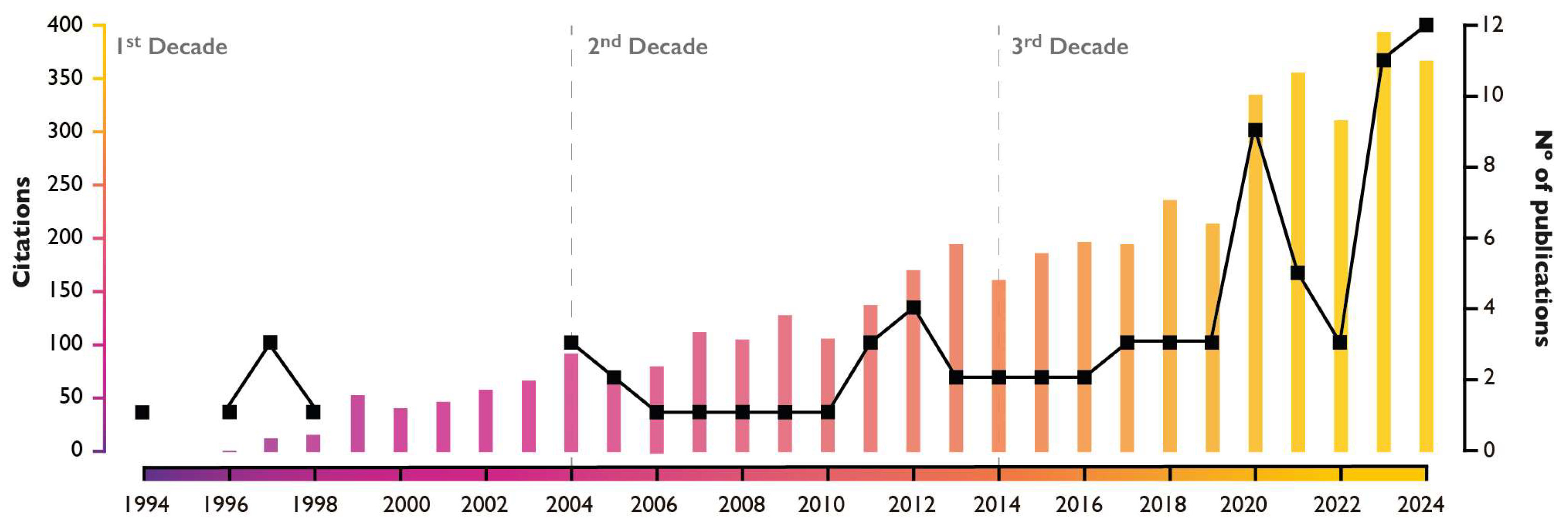
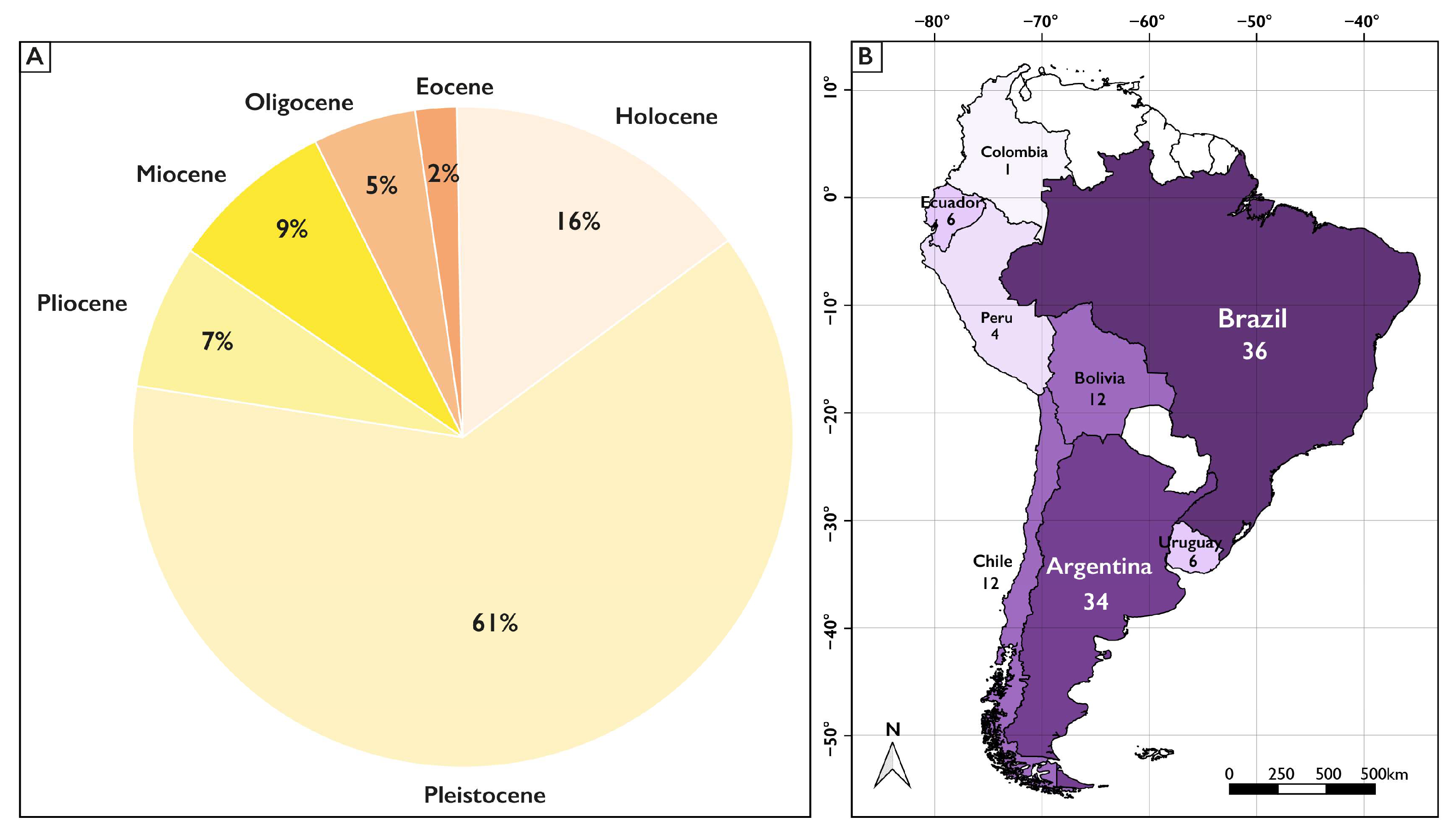
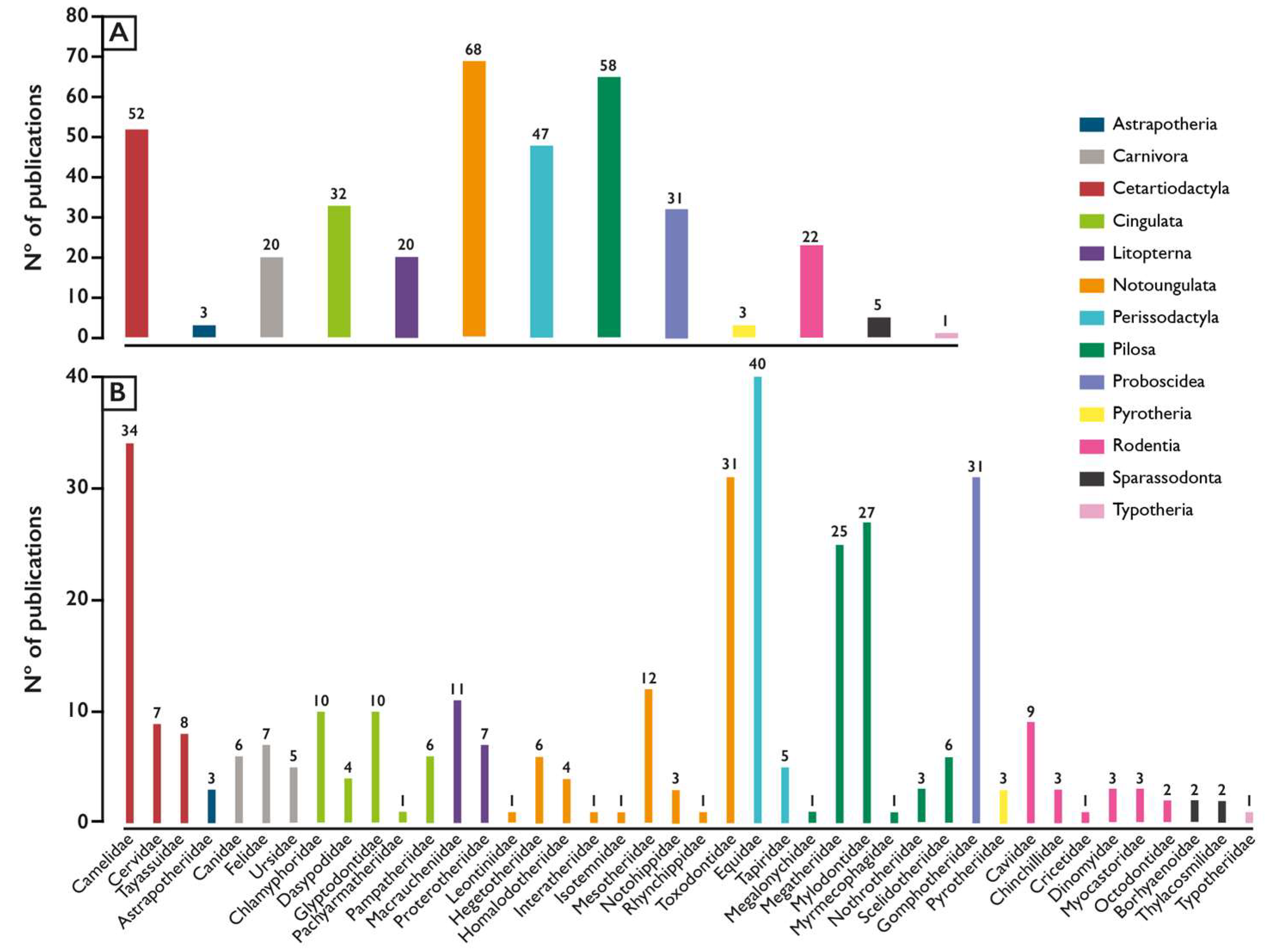
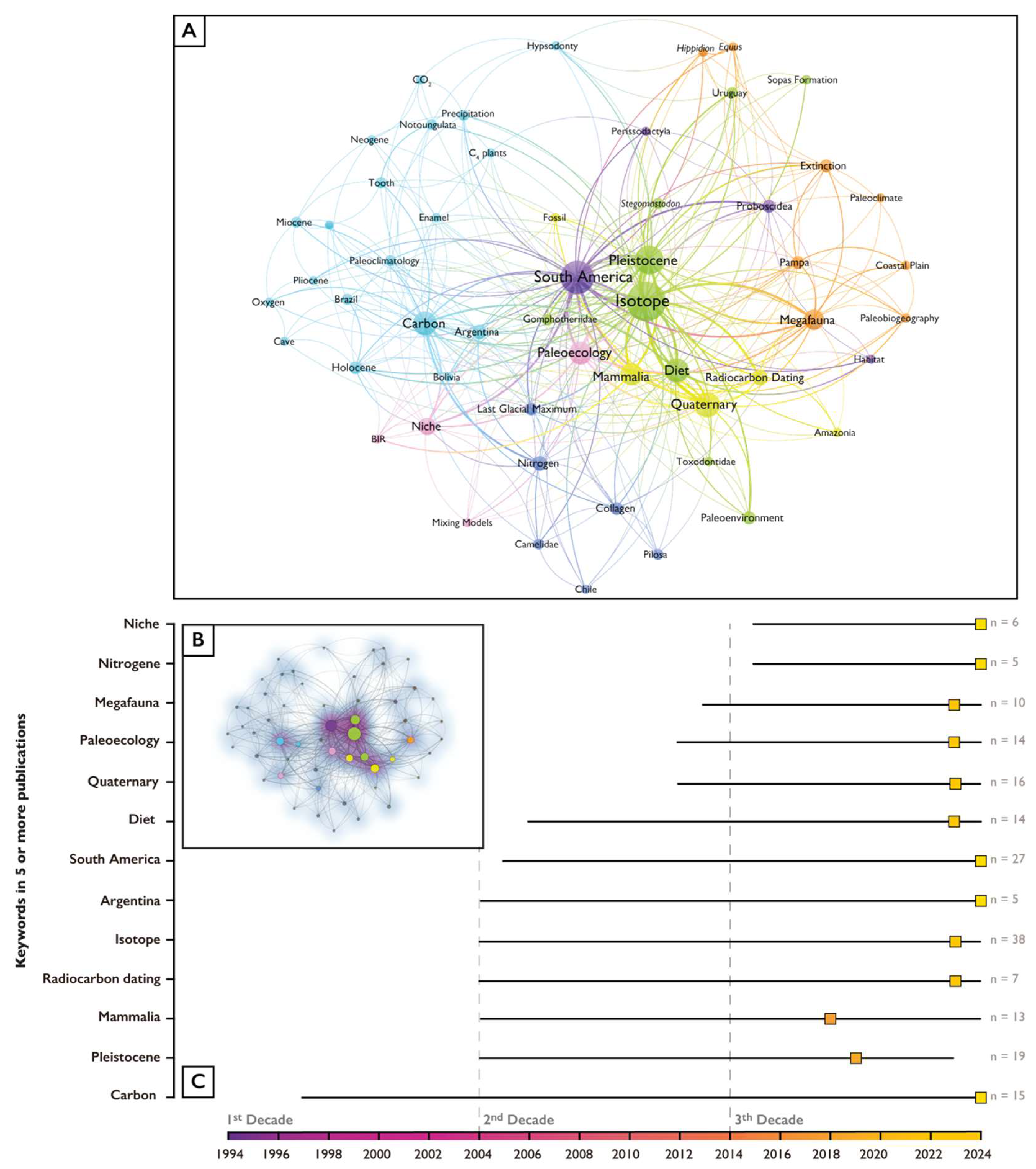

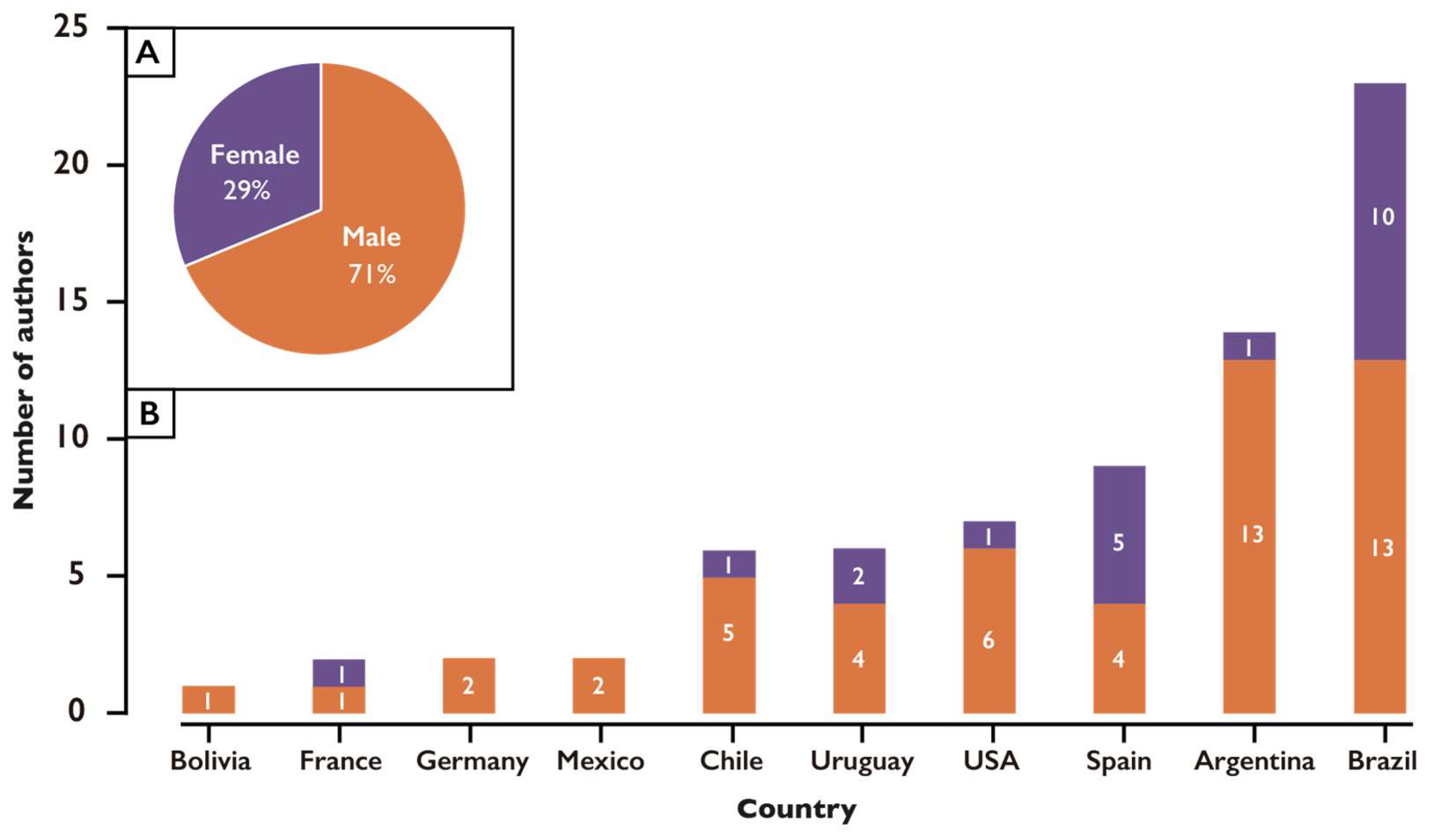
| Journal | n | % | 1st Decade 1994–2004 | 2nd Decade 2005–2014 | 3rd Decade 2015–2024 |
|---|---|---|---|---|---|
| Quaternary Science Reviews | 10 | 12.8 | - | 1 | 9 |
| Journal of South American Earth Sciences | 6 | 7.7 | - | - | 6 |
| Palaeogeography, Palaeoclimatology, Palaeoecology | 6 | 7.7 | 1 | 1 | 4 |
Disclaimer/Publisher’s Note: The statements, opinions and data contained in all publications are solely those of the individual author(s) and contributor(s) and not of MDPI and/or the editor(s). MDPI and/or the editor(s) disclaim responsibility for any injury to people or property resulting from any ideas, methods, instructions or products referred to in the content. |
© 2025 by the authors. Licensee MDPI, Basel, Switzerland. This article is an open access article distributed under the terms and conditions of the Creative Commons Attribution (CC BY) license (https://creativecommons.org/licenses/by/4.0/).
Share and Cite
Sanz-Pérez, D.; Tomassini, R.L.; Hernández Fernández, M. Isotopic Studies in South American Mammals: Thirty Years of Paleoecological Discoveries. Geosciences 2025, 15, 284. https://doi.org/10.3390/geosciences15080284
Sanz-Pérez D, Tomassini RL, Hernández Fernández M. Isotopic Studies in South American Mammals: Thirty Years of Paleoecological Discoveries. Geosciences. 2025; 15(8):284. https://doi.org/10.3390/geosciences15080284
Chicago/Turabian StyleSanz-Pérez, Dánae, Rodrigo L. Tomassini, and Manuel Hernández Fernández. 2025. "Isotopic Studies in South American Mammals: Thirty Years of Paleoecological Discoveries" Geosciences 15, no. 8: 284. https://doi.org/10.3390/geosciences15080284
APA StyleSanz-Pérez, D., Tomassini, R. L., & Hernández Fernández, M. (2025). Isotopic Studies in South American Mammals: Thirty Years of Paleoecological Discoveries. Geosciences, 15(8), 284. https://doi.org/10.3390/geosciences15080284








